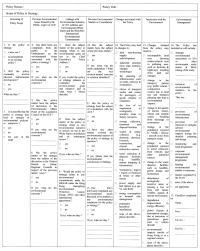| This step is to screen areas or issues required for SEA and what aspects of the areas need to be studied.  Screening Screening The main purpose of screening is to identify areas or aspects of PPPs having potentially significant sustainability and environmental implications and to decide whether SEA is required and if so, the type and level of SEA that might be required. There are various methods available for screening such as the use of checklists, inclusion lists, exclusion lists, initial environmental evaluations, seeking professional advices from competent authorities and so on.
Screening - To help proponents identify areas of PPPs worth for SEA, a one-page checklist was issued in 1998 as part of a government circular. The checklist aims to help proponents, who generally do not have much environmental knowledge, to identify environmental concerns in a structured and systematic manner, and to establish connections between PPPs and environmental implications. For instance, the checklist can prompt the users to check whether their PPPs would link to any environmental policies or issues such as transportation, power supply and consumption, major land use and infrastructure developments, ecologically sensitive areas, or whether there had been relevant environmental comments or views raised by the public. The checklist is shown in Figure 8.
(click to enlarge)
 Figure 8 - Checklist for Environmental Appraisal of Policy or Strategy Submitted to the Executive Council
Source: The former Planning, Environment and Lands Bureau's Technical Circular No. 10/98
Figure 8 - Checklist for Environmental Appraisal of Policy or Strategy Submitted to the Executive Council
Source: The former Planning, Environment and Lands Bureau's Technical Circular No. 10/98
 Scoping Scoping
Scoping helps define environmental issues to be assessed, to what level of details and by what kind of methodologies during each stage of the SEA. In deciding the level of assessments and types of methodologies, considerations such as funding issues, time allowed for the SEA should be evaluated. The breadth and depth of the assessment should tally with the level of decision and should at least help to confirm the environmental acceptability and preference of options considered. If a SEA is to be completed within a tight schedule and only preliminary data and findings are available but with much uncertainty, one of the most important steps is to inform the decision makers of the real situation and limitations so that a conscious decision could be made. Approaches and methodologies for SEA may vary remarkably ranging from comprehensive to very simple methods. Project proponents should seek assistance from relevant authorities or professionals specializing in SEA at the earliest possible stage to ensure a timely completion of SEA and to avoid late focus of major environmental issues. Early consultations with the Environmental Protection Department (EPD) are recommended.
Scoping - To help project proponents to scope relevant environmental issues to be studied in SEA, EPD would work closely with proponents to draft a tailor-made study brief for each SEA (to view the key SEA Study Brief, please go to Key SEA Study Briefs page). Meanwhile, considering that new issues might emerge in the course of SEA, which is a common problem for strategic studies, an Environmental Study Management Group chaired by a directorate officer of EPD, would be formed to manage the SEA study. This also helps facilitate an early dialogue on major issues, and a better coordination and arrangement. It also helps ensure that environmental issues are assessed in a professional and focused manner, maximizing the opportunities for more sustainable outcomes.
|

 Strategic Environmental Assessment (SEA) Knowledge Centre
Strategic Environmental Assessment (SEA) Knowledge Centre 